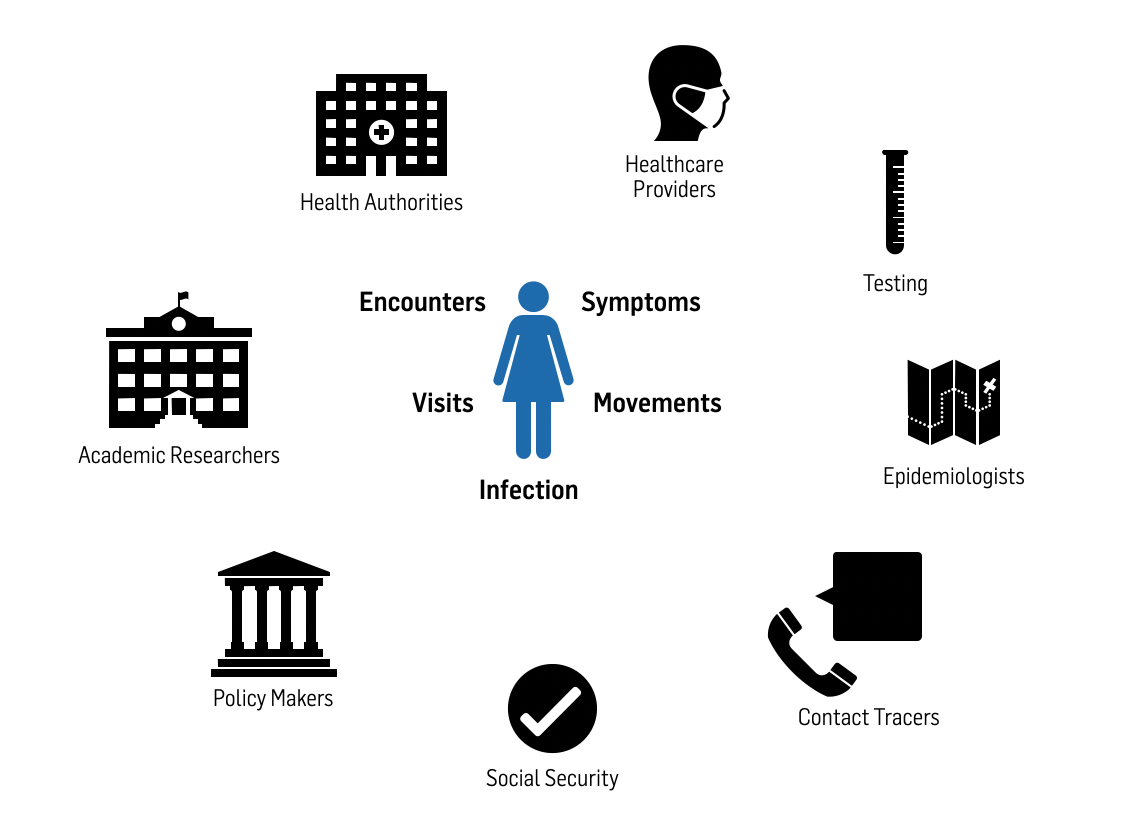Difference between revisions of "Overall system"
| Line 1: | Line 1: | ||
= Exploring the full landscape = |
= Exploring the full landscape = |
||
| + | [[File:overallsystem.png]] |
||
| − | [Insert drawing] |
||
Our scope is the contribution of mobile technology available to citizens (iOS and Android equipped smartphones) to the prevention of the spread of the COVID-19 pandemic. |
Our scope is the contribution of mobile technology available to citizens (iOS and Android equipped smartphones) to the prevention of the spread of the COVID-19 pandemic. |
||
Latest revision as of 07:04, 20 May 2020
Exploring the full landscape
Our scope is the contribution of mobile technology available to citizens (iOS and Android equipped smartphones) to the prevention of the spread of the COVID-19 pandemic.
The System under study is thus the sum of components that interplay in the prevention :
- The citizen equipped with a smartphone, having encounters with other persons, doing visits to points of interest, making movements and showing symptoms.
- The healthcare system including health authorities, testing facilities, healthcare providers, epidemiologists, contact tracers
- Academic researchers
- Policy makers
- Social support providers (in charge of organising social-economical aspects of isolation and quarantining)
- Users of other similar systems
The goals of the system are:
- As a whole: to limit the combined health and economical damage caused by the pandemic
- As means to this end:
- Empower citizens to take effective and more targeted social distancing measures (ref: EC Recommendation of 8.4.2020), including informing users of increased potential exposure and advising them on adequate measures, supporting their relationship with healthcare providers.
- Support contact tracing at scale (ref: EC Recommendation of 8.4.2020), which we extend to ‘transmission tracing’ to encompass explicitly all transmission routes beyond person-to-person contacts.
- Inform policy makers on measures and exit strategy (ref: EC Recommendation of 8.4.2020) through spatio-temporal analysis of data on spread and impact of the virus.
- Assess the effectiveness of measures
- Optimize resource allocation (e.g. testing) and utilization (e.g. triage) in order to avoid overburdening the healthcare system and yield the maximal impact of available resources
- Support the organizing of effective isolation of infected individuals and quarantining of suspected infections, including the social-economical aspects
- Enable scientific research on the pandemic and the fight against the pandemic
- We explicitly exclude law enforcement and mass surveillance.
This requires the following features:
Inform citizens:
- General preventive guidelines and warnings
- Targeted preventive guidelines and warnings
- Information about the status of the pandemic
- Information about the measures and policies
Support transmission tracing(*)
- Processes:
- Identify and isolate infected individuals (index cases)
- Track encounters of the index cases in order to quarantine them awaiting testing according to a monitoring protocol (building contact graphs and backtracking the index case’s contacts)
- Identify visits to points of interest and movements of the index cases
- Identify hotspots (indicators for environmental transmission or unidentified encounters) based on the correlation of visits to points of interest or locations with infection incidence
- Identify the ‘most central individual’ in a network so as to target tests for maximal network coverage
- Identify super spreaders
- Provide warnings and instructions (isolation, quarantining, testing)
Support healthcare provisioning:
- Pre-disease self-diagnosing (e.g. health / symptoms diary)
- Preparing a doctor’s visit (e.g. pre-anamnesis / medical history / triage)
- Post-diagnosis contact on treatment and symptoms evolution
Inform policy making:
- Provide aggregated dashboards of relevant indicators
- Model and predict the evolution of the disease based on spatio-temporal mapping of symptoms and infections based on monitoring of consenting individuals of their (para-)medical data and location and movements
Monitor the effectiveness of decision-making by authorities on measures such as social distancing and confinement
- Correlate spatio-temporal symptom and infection mapping with measures taken
Optimize resource allocation
- Targeted testing
- Capture and consolidate information
- Efficient use of contact tracers (and thus reduce the amount of people needed)
Organize quarantining
- Certify infection and exposure data
- Support appropriate information exchange between actors (index case, employer, care givers, healthcare providers, social security)
Enable research
- Conduct surveys among the population
- Provide adequately protected data
(*) We choose the term ‘transmission tracing’ rather than ‘contact tracing’ in order to explicitly include transmission modes beyond person-to-person transmission.
